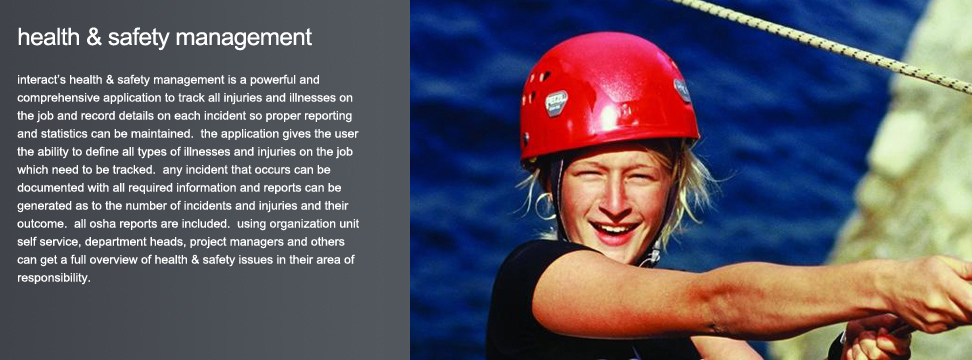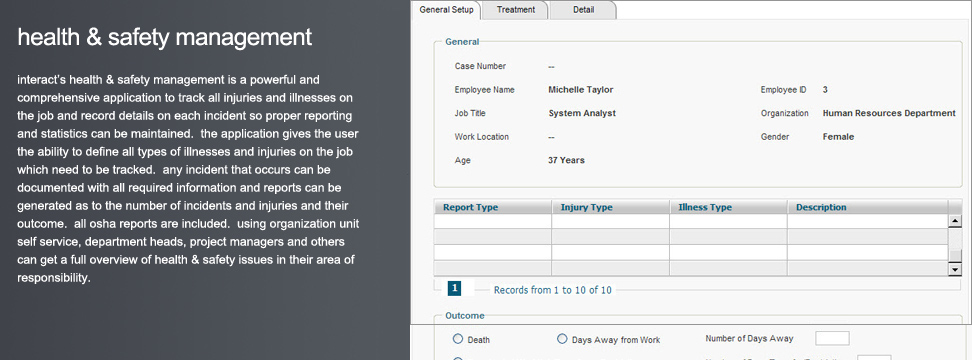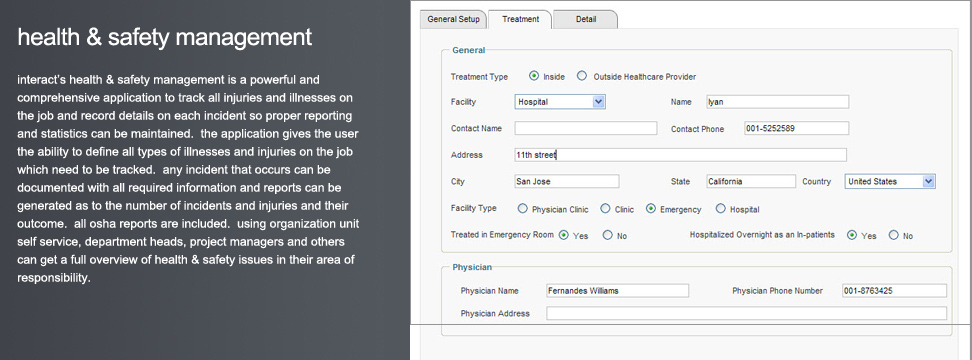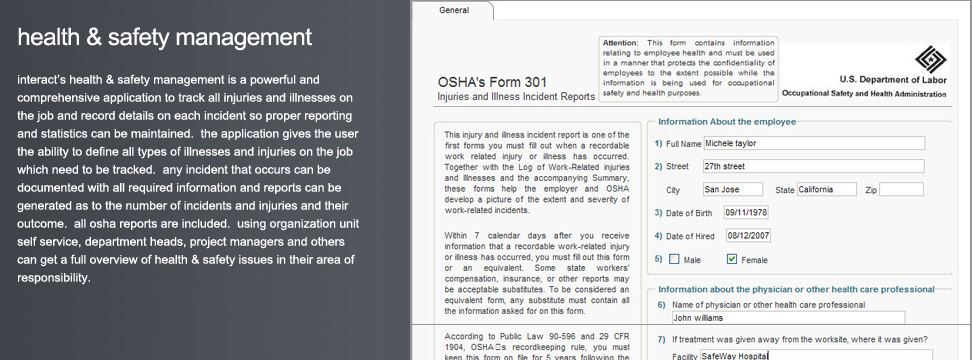Interact HRMS Health & Safety Management Module Overview
The Interact HRMS Health & Safety Management module provides organizations with a powerful tool for managing workplace health, safety, and environmental (HSE) concerns. This module enables companies to define and apply standardized HSE classifications, track injuries and illnesses, and maintain a comprehensive injury log, helping organizations meet regulatory requirements and create a safe working environment. By centralizing health and safety data within a structured framework, the Health & Safety Management module supports proactive risk prevention, ensuring that companies can act to minimize workplace incidents and protect employee well-being.
This module is particularly valuable for organizations that prioritize workplace safety and wish to comply with HSE standards. With configurable injury and illness classifications, an integrated injury reporting process, and robust data analysis capabilities, the module enables HR and safety officers to track, report, and respond to workplace injuries and illnesses efficiently. By creating a detailed record of each incident, organizations can identify trends and implement measures to reduce the risk of future occurrences, fostering a culture of safety and responsibility.
Defining HSE Classification Standards for Consistent Tracking
The foundation of the Health & Safety Management module is its ability to define and apply standardized HSE classifications for tracking workplace injuries and illnesses. This classification system allows organizations to categorize incidents according to predefined health and safety standards, ensuring that all reported injuries and illnesses are documented consistently. By establishing clear HSE classifications, organizations can create a structured approach to health and safety reporting that supports compliance with industry regulations.
Once the HSE classification has been set, specific types of injuries and illnesses can be defined within the module. These definitions become part of the organization’s standard reporting mechanism, enabling HR and safety officers to categorize incidents accurately and consistently. For example, an organization might define classifications for common injuries such as fractures, sprains, or burns, as well as illness types related to repetitive strain, respiratory issues, or chemical exposure. This standardization supports efficient data analysis and ensures that safety reports reflect consistent terminology.
Comprehensive Injury and Illness Tracking
The Health & Safety Management module provides organizations with a comprehensive system for recording workplace injuries and illnesses. When an incident occurs, HR and safety officers can log the details in the module, linking the record directly to the affected employee’s profile. This record includes a detailed description of the injury or illness, allowing for complete documentation of the incident and its circumstances.
Each injury or illness record can be reviewed and approved by authorized personnel to ensure accuracy and compliance. Once finalized, the record is stored in the employee’s electronic file, providing a permanent, accessible record of the incident. By tracking injuries and illnesses at the individual level, the module enables organizations to monitor health and safety events across the workforce and respond effectively to each case.
Injury Log with Detailed Accident and Treatment Information
The module’s Injury Log provides a comprehensive record of each workplace incident, capturing essential information about the accident, treatment, and circumstances under which the injury or illness occurred. Key details recorded in the Injury Log include:
- Specific Accident Information: Describes the nature of the accident, including where and when it occurred, as well as any contributing factors.
- Injury Treatment Details: Documents the treatment administered, whether first aid was provided on-site, or if the employee was referred to medical professionals.
- Circumstances of the Incident: Provides context for the incident, helping to identify underlying causes, such as equipment failure, hazardous materials, or unsafe working conditions.
By capturing these details, the module enables HR and safety teams to create a full picture of each incident. This information is invaluable for conducting investigations, identifying root causes, and ensuring that corrective actions are taken to prevent similar incidents in the future. The Injury Log provides a centralized repository of safety incidents, supporting thorough documentation and promoting accountability within the organization.
User-Defined Codes for Accurate Incident Classification
The module includes user-defined codes for tracking illnesses and injuries, allowing organizations to use customized terminology that aligns with their specific operational needs. These codes provide a standardized way to categorize incidents, making it easy for HR and safety officers to log, analyze, and report on workplace injuries and illnesses accurately. By using codes tailored to the organization’s environment, the module ensures that health and safety data is both relevant and easy to interpret.
For example, an organization operating in a manufacturing environment may create codes for specific injury types, such as “Machine-Related Injury” or “Chemical Exposure.” These codes make it easy to categorize incidents in a way that reflects the unique hazards of the workplace. Standardized codes also support trend analysis, enabling organizations to track patterns and identify areas that require additional safety measures.
Reporting for Trend Analysis and Preventive Actions
The Health & Safety Management module provides reporting capabilities that allow organizations to generate detailed reports on workplace injuries and illnesses. These reports help HR and safety teams analyze incident trends, identify underlying causes, and develop targeted prevention strategies. By examining data over time, organizations can detect recurring patterns, such as frequent injuries in specific departments or an increase in certain types of illnesses.
This data-driven approach to health and safety management enables organizations to implement proactive measures that address the root causes of incidents. For example, if data shows a high incidence of repetitive strain injuries in a particular department, the organization might implement ergonomic improvements or provide additional training on safe work practices. By using data to drive preventive actions, the module supports a proactive approach to workplace safety, helping organizations reduce incidents and create a safer work environment.
Integration with Employee Electronic Records for Centralized Documentation
The module integrates seamlessly with the employee electronic record system, allowing all health and safety incidents to be linked directly to individual employee profiles. This integration creates a centralized, easily accessible repository of all health and safety data, making it easy for HR and safety officers to view each employee’s incident history. This centralization promotes accountability and ensures that safety records are readily available for audits, reviews, or regulatory reporting.
For example, if an employee has sustained multiple injuries over time, HR can quickly review their incident history to assess any patterns and determine if additional safety training or preventive measures are needed. This integration supports comprehensive documentation, helping organizations maintain accurate records and respond effectively to each incident.
Compliance with HSE Regulations and Standards
The Health & Safety Management module is designed to support organizations in meeting health, safety, and environmental (HSE) regulations. By providing a structured framework for incident classification, tracking, and reporting, the module helps organizations comply with regulatory requirements for workplace safety. The module’s standardized reporting capabilities ensure that all incidents are documented in accordance with industry best practices, supporting compliance with local and international HSE standards.
With built-in review and approval processes, organizations can ensure that each reported incident meets regulatory standards for accuracy and completeness. This compliance-focused approach to health and safety management helps organizations avoid penalties and maintain a safe, legally compliant work environment.
Proactive Risk Management and Incident Prevention
The Health & Safety Management module supports a proactive approach to risk management by enabling organizations to identify and address safety risks before they escalate. By tracking incident data and analyzing trends, organizations can implement preventive measures that reduce the likelihood of future incidents. The module also supports ongoing safety education, helping organizations raise awareness of common risks and encourage safe work practices.
For example, if data analysis reveals a high frequency of slip-and-fall incidents in certain areas, the organization might improve flooring or introduce non-slip surfaces to mitigate this risk. By taking proactive steps based on real data, organizations can create a safer environment for their employees, fostering a culture of safety and responsibility.
Summary: Interact HRMS Health & Safety Management
The Interact HRMS Health & Safety Management module provides organizations with a structured, proactive approach to managing workplace health and safety. Key benefits include:
- Standardized HSE Classification: Define and apply HSE classifications to ensure consistent tracking of injuries and illnesses.
- Comprehensive Injury and Illness Tracking: Record detailed information on each incident, linked to the employee’s electronic profile.
- Injury Log with Detailed Accident and Treatment Information: Document accident details, treatment received, and incident circumstances for thorough analysis.
- User-Defined Codes for Incident Classification: Customize incident codes to align with organizational needs for accurate categorization.
- Automated Reporting for Trend Analysis: Generate detailed reports to identify trends and inform preventive actions.
- Integration with Employee Records: Link safety incidents to employee profiles for centralized documentation and easy access.
- Regulatory Compliance Support: Meet HSE standards through structured incident tracking and reporting.
- Proactive Risk Management: Use data-driven insights to prevent future incidents and promote a safer work environment.
By combining these features, the Health & Safety Management module helps organizations maintain a safe workplace, meet regulatory standards, and implement proactive measures to protect employees. This structured approach to health and safety management enhances operational resilience, supports compliance, and fosters a culture of safety across the organization.




